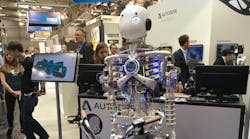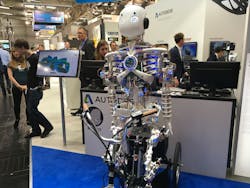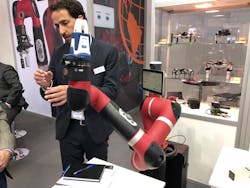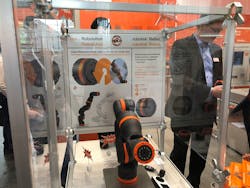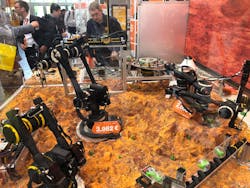Hannover Messe Fair 2018 concluded last month and highlighted several advanced use cases in advanced motion. The overall theme was how to take existing motion products and bring them into the digital renaissance occurring today. The Internet of Things, connected networks, data gathering, and digitization are changing how we define products—even ones that have a strong mechanical focus. Here are some of the highlights from Hannover Messe that are blending advanced mechanical motion with digitization.
B&R Robotic Digital Twin
B&R have combined the robotic arm assembly line with the digital twin. In the system shown above, the digital twin provides the robotic movements, autonomous traffic control, collision avoidance, and predictive maintenance. The digital twin also allows users to create 3D visualization and run simulation based on machine runtime code. This helps system integrators to ensure that the path of the robot is safe and precise prior to turning on the automation system.
Eye Tracking Systems with Omron
The Omron company debuted its eye tracking system for automotive vehicles. The advanced camera system keeps track of the driver’s movements to ensure that they are aware and attentive while driving. The vestibulo-ocular reflex (VOR) tracking system has drowsiness prediction capabilities via deep eye sensing. The optical system used combines LED lights and IR cameras to detect the driver’s face. It measures angle of the eyes, when the eyes are opened and closed, and facial expressions.
Advanced Gearbox Line from Wittenstein
The new Galaxie gearbox line up blends the mechanical gear systems with modern encoder and interconnected features. The lineup features three sizes: the compact Galaxie D in size 085, for use in smaller cutting heads or handling axes where special requirements apply regarding torsional rigidity and freedom from backlash; the new ultra-flat Galaxie DF in sizes 110 and 135, which saves up to 30% of the normal installation length; and the Galaxie GH, with its optional right-angle input stage.
The flexible encoder interfaces allow Galaxie to be easily integrated into existing machine concepts such as machine tools, cutting heads, and robot welding guns. The Galaxie gearboxes collect operating data that can be transmitted to an IoT cloud using a Galaxie Drive System equipped with sensors. This data can be accessed anywhere and on any device throughout the drive lifecycle, regardless of the control system.
Bosch Rexroth’s Hydraulic Cartridge Valves Use Real-Time AR Visualization
The new generation of WRC-4X directional cartridge valves offers a new level of performance and communication for hydraulic actuators. The new cartridge valve blocks are targeted primarily at applications with high flow and dynamics requirements such as presses, die casting, and injection molding machines. The new cartridge valves are more dynamic and have optimized channel geometries, enabling different sized valves to achieve significantly higher flows than was previously possible or only achievable by going up a size. The valves can be operated via digital and analog control.
In both cases, the integrated electronics (OBE) enable the valves to be seamlessly integrated into digitally networked automation environments and IoT applications. The multi-Ethernet interface supports all conventional real-time protocols such as SERCOS, EtherCAT, and Varan. WRC-4X valves also feature the Open Core Interface (OCI) for Drives, an open interface that enables communication with a range of programs. The cartridge valve performance can also be mapped in real-time (as shown above) by using augmented reality technology to view the hydraulic flow performance.
The Genius and Smart Cab Concept Cluster at the Bosch Rexroth Booth
Bosch showcased its involvement in the Genius and Smart Cab projects developed especially for construction machinery. The Genius and Smart Cab is a full visually integrated system using advanced cameras and sensors. Ultrasonic and video sensors monitor the vehicle’s surroundings more thoroughly than any rear-view mirror, which prevents downtime due to accidents. The vehicle operating data can be analyzed to the nearest second on a tablet display. These surround sensors are an important step in the process of giving construction vehicles more intelligence, and so making them even safer. In the above photo, Technology Editor Jeff Kerns is receiving a hands-on tutorial on how the advanced systems operates.
Autodesk Presents Roboy: The Future of Humanoid Robots
A network of 100 research laboratories and more than 100 students and scientists of the TU Munich robotics program have worked on the Roboy project. Robots are still in the early stages of moving smoothly and as agile as a human being. Robots like that from Boston Dynamics have been able to replicate natural movement but it has yet to be refined. An important step in furthering this analysis is to build a mechatronic structure that makes human-like movements possible in the first place. The Roboy platform allows researchers to explore the interaction of muscles that enables human-like soft and flexible movements.
The team at TU Munich, along with the Chinese University of Hong Kong, Human Brain Project of Stockholm, and Oxford University, used Autodesk Fusion 360 to construct the exoskeleton and lay out the artificial tendons that allow Roboy to move. The team also developed its own cognitive system based on current algorithms from artificial intelligence and natural speech processing. All the programming and manufacturing techniques are open source. The project hopes to make important contributions to the development of robots and understanding of the human body.
Easy Swapping of Tools with Rethink Robotics’ Sawyer
The Rethink Robotics booth was the busiest it’s ever been at this year’s Hannover Messe Fair. Part of the excitement, besides Sawyer’s natural charm, was the new ClickSmart Plate, part of the ClickSmart family. The ClickSmart Plate features a quick release mechanism lets you swap end-effectors fast and efficiently without using any tools. Embedded sensors store the configuration of the connected end-effector when the ClickSmart Plate is attached to a Sawyer collaborative robot. It immediately recognizes the type of end-effector and knows how to control it. ClickSmart Gripper Kits contain all the components you need to quickly build and customize gripping solutions for a wide range of tasks. The plug and play kits greatly reduce the need for costly custom design and enable faster deployment of customized grippers in cobots.
The robolink ReBeL
Known for their plastic bearings and e-chains, igus is taking a new direction into robotics. Robots are becoming smaller, more precise, and lightweight. Collaborative robots especially have driven the market as of late to help companies introduce safety into their work environments. igus is looking to introduce plastic-driven robots that are efficient and affordable. The robolink ReBeL Joint features injection-molded components which are cost-effective and flyweight. Instead of using stepper motors, ReBeL uses light, brushless direct current motors (BLDC motors). The joints, being made of polymers, are cost-efficient and light for up to 6 deg. of freedom.
The motors, control technology, and cable guidance are all built into the housing and the joints themselves are suitable for service-robotics applications. Due to their small size, the space-saving BLDC motors can be installed in the strain wave gear of a robolink joint. The control electronics system is also built into the axes and an external switch cabinet is not required. Cable guidance can take place in the arm, the result being that the outer contours of the robot are smooth. The ReBeL joints are particularly suitable for mobile applications in which a robotic arm is mounted on a moving platform. This includes application areas such pick and place tasks, collection, and delivery services.
The New Apiro Robolink from igus
The robotics field is an ever-evolving field. In order to make automatic processes possible cost-effectively and individually, igus is developing low-cost solutions with the help of high-performance plastics such as the new modular motion system, robolink Apiro. The focus was on decoupling the motor and gearbox as well as on the introduction of completely new kinds of worm gear for the achievement of six axes—for example, in an articulated robot. A gearbox with linear motion is planned as are inverted and conventional robolink worm gears in four different sizes are planned. Due to the modularity of the system, they can be combined with each other as required.
Complicated movements can be implemented with the new Apiro system. For example, cost-effective and individual SCARA robots and linear robots, transport and handling systems, and humanoid and animatronic robots which can perform movements like those of a spider. The new robolink series is also suitable for training, development, and research, as different kinematics can be set up quickly and easily.
As with all igus products, the focus is on plastics. The series features high-quality tribo-polymers with solid lubricants; these are corrosion-free and chemical-resistant high-performance plastics. They ensure a high degree of stability, low weight, a long service life, and freedom from the need for maintenance. The system itself is joined together with multifunctional profiles made of aluminum. This makes it possible to insert drive shafts through the hollow space in the middle, causing the aluminum profile to rotate. The new worm gear with linear movement allows the aluminum profile to travel linearly through the worm gear or the worm gear travels on the linear profile. Placing several Apiro joints side by side makes parallel joint connections possible as well. This results in innumerable possibilities of combination to automate several different applications.










